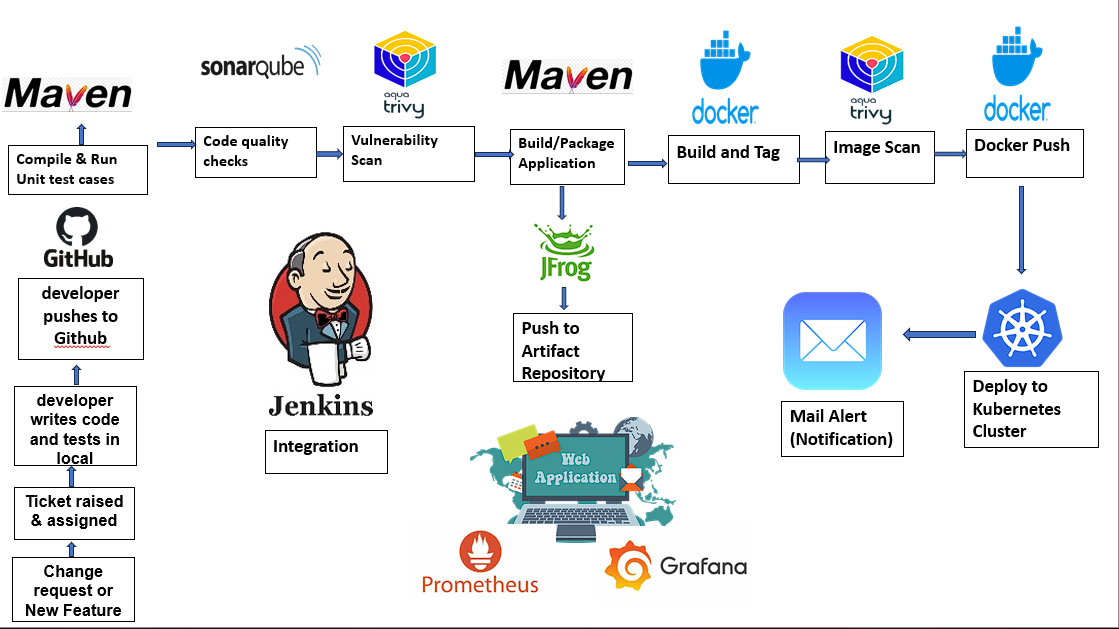Problem Statement
In our AMRIT software development and deployment workflows, teams often facing challenges such as:
- Slow-release cycles due to manual processes and lack of automation.
- Inefficient collaboration between development and operations teams, leading to deployment failures.
- Inconsistent environments across development, testing, and production, causing unexpected issues.
- Security vulnerabilities due to inadequate scanning and compliance checks.
- Lack of observability in system performance, making issue resolution difficult.
These challenges result in delayed product releases, reduced reliability, increased operational costs, and customer dissatisfaction.
Objective
The goal of this DevOps Roadmap is to:
- Streamline CI/CD pipelines to enable faster and more reliable deployments.
- Enhance collaboration between development, operations, and security teams.
- Ensure infrastructure as code (IaC) for consistent and reproducible environments.
- Integrate security practices (DevSecOps) to minimize vulnerabilities.
- Implement monitoring and logging to improve system reliability and issue resolution.
- Optimize containerization and orchestration using Docker and Kubernetes.
Introduction
This document outlines the roadmap for implementing DevOps practices for our project. It includes the tools and technologies we will use, the CI/CD pipeline setup, security practices, and monitoring strategies.
Development Stack:
- Backend: JDK 17 LTS, Spring Boot 3.2
- Frontend: Angular 16
- Application Server: Wildfly 30
- Database: MySQL 8
DevOps Tools:
- Version Control: Git
- Build & Dependency Management: Node.js, NPM
- Artifact Repository: JFROG
- Code Quality & Security: SonarQube, Trivy
- Dependency Vulnerability Scanning: OWASP
- CI/CD Pipeline: Jenkins
- Containerization & Orchestration: Docker, Kubernetes (K8s)
DevOps Implementation Plan
1. Source Code Management
- Use Git for version control with branching strategies
- Host repositories on a central platform (GitHub).
2. Continuous Integration (CI)
- Automate builds using Jenkins.
- Run unit tests and static code analysis (SonarQube) on every commit.
- Ensure security scanning with Trivy.
3. Artifact Management
- Store built artifacts in an artifact repository (JFROG).
4. Continuous Deployment (CD)
- Use Jenkins to automate deployments.
- Deploy Spring Boot applications to Wildfly 30.
- Deploy apps using CI/CD pipeline.
- Manage environment-specific configurations.
5. Containerization & Orchestration
- Use Docker to containerize applications.
- Deploy and manage containers using Kubernetes (K8s).
- Implement Helm charts for Kubernetes deployments.
6. Security Best Practices
- Use SonarQube for code security analysis.
- Implement Trivy for container vulnerability scanning.
- Enable SSL/TLS for secure communication.
- Use role-based access control (RBAC) in Kubernetes.
7. Monitoring & Logging
- Implement centralized logging using ELK Stack (Elasticsearch, Logstash, Kibana) with Grafana.
- Use Prometheus for application and infrastructure monitoring.
- Configure alerts for failures and performance issues.
8. Backup & Disaster Recovery
- Regular database backups.
- Implement Kubernetes backup strategies.
- Automate recovery processes for quick restoration.
Current Stage of CI/CD pipeline:
Expected pipeline:
Conclusion
By implementing this roadmap, we aim to achieve a fully automated, scalable, and secure DevOps ecosystem that enhances productivity and ensures high software quality.


